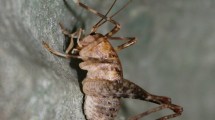Summary
-
1.
The dynamic behaviour of the cockroach femoral tactile spine can be characterised as fractional differentiation. In the frequency domain this corresponds to a frequency response function which can be completely represented by two parameters: the gain at a frequency of 1 radian/s and an exponent of frequency.
-
2.
Frequency response functions for mechanotransduction in the tactile spine have been measured at temperatures in the range of 10–40 °C. Sensory transduction fails at temperatures a few degrees Celsius outside this range.
-
3.
The effect of temperature upon sensory transduction is to multiply the entire response by a constant factor, independent of frequency, at each temperature. The multiplication factor increases with warming up to about 35 °C and then decreases rapidly. The data up to 35 °C is well fitted by an Arrhenius relationship with an activation energy of 18.6 kcal/ mole.
-
4.
Changing the temperature has no effect upon the exponent of frequency which stays constant at approximately 0.5, corresponding to a system which performs semi-differentiation.
-
5.
The possible sites of temperature sensitivity and sensory transduction in these mechanoreceptors are discussed. Possible origins of the semi-differentiation behaviour are reviewed and a visco-elastic travelling wave model of the tubular body is suggested. Comparisons are drawn throughout to the behaviour of Pacinian corpuscles, muscle spindle primary afférents and other cuticular mechanoreceptors.
Similar content being viewed by others
References
Chapman KM, Pankhurst JH (1967) Conduction velocities and their temperature coefficients in sensory nerve fibres of cockroach legs. J Exp Biol 46:63–84
Chapman KM, Smith RS (1963) A linear transfer function underlying impulse frequency modulation in a cockroach mechanoreceptor. Nature 197:699–700
Chapman KM, Mosinger JL, Duckrow RB (1979) The role of distributed viscoelastic coupling in sensory adaptation in an insect mechanoreceptor. J Comp Physiol 131:1–12
French AS (1980) Sensory transduction in an insect mechanoreceptor: linear and nonlinear properties. Biol Cybern 38:115–123
French AS, Holden AV (1971) Alias-free sampling of neuronal spike trains. Kybernetik 8:165–171
French AS, Kuster JE (1981) Sensory transduction in an insect mechanoreceptor: extended bandwidth measurements and sensitivity to stimulus strength. Biol Cybern 42:87–94
French AS, Sanders EJ (1981) The mechanosensory apparatus of the femoral tactile spine of the cockroach,Periplaneta americana. Cell Tissue Res 219:53–68
French AS, Holden AV, Stein RB (1972) The estimation of the frequency response function of a mechanoreceptor. Kybernetik 11:15–23
Gnatzy W (1980) Ultrastructure and mechanical properties of an insect mechanoreceptor: stimulus-transmitting structures and sensory apparatus of the cereal filiform hairs ofGryllus. Cell Tissue Res 213:441–463
Grandori F, Pedotti A (1980) Theoretical analysis of mechano-to- neural transduction in Pacinian corpuscle. IEEE Trans Biomed Eng 27:559–565
Heitler WJ, Goodman CS, Rowell CHF (1977) The effects of temperature on the threshold of identified neurons in the locust. J Comp Physiol 117:163–182
Holden AV (1976) Models of the stochastic activity of neurones. Springer, Berlin Heidelberg New York
Hunt CC, Wilkinson RS (1980) An analysis of receptor potential and tension of isolated cat muscle spindles in response to sinusoidal stretch. J Physiol 302:241–262
Huxley AF (1959) Ion movements during nerve activity. Ann NY Acad Sci 81:221–246
Ishiko N, Loewenstein WR (1961) Effects of temperature on the generator and action potentials of a sense organ. J Gen Physiol 45:105–124
Eewis CT (1970) Structure and function in some external receptors. Symp R Entomol Soc (Lond) 5:59–76
Loewenstein WR (1959) The generation of electrical activity in a nerve ending. Ann NY Acad Sci 81:367–387
Loewenstein WR, Mendelson M (1965) Components of receptor adaptation in a Pacinian corpuscle. J Physiol 177:377–397
Matthews BCH (1933) Nerve endings in mammalian muscle. J Physiol 78:1–53
McIver SB (1975) Structure of cuticular receptors in arthropods. Annu Rev Entomol 20:381–397
Moore RK (1960) Travelling-Wave Engineering. McGraw-Hill, New York
Moran DT, Varela FG (1971) Microtubules and sensory transduction. Proc Natl Acad Sci USA 68:757–760
Moser H, Ottoson D, Rydqvist B (1979) Step-like shifts of membrane potential in the stretch receptor neuron of the crayfish (Astacus fluviatilis) at high temperatures. J Comp Physiol 133:257–265
Oldham KB, Spanier J (1974) The Fractional Calculus. Academic Press, New York
Rice MJ (1975) Insect mechanoreceptor mechanisms. In: Sensory Physiology and Behaviour. Galun R, Hillman P, Parnas I, Werman R (eds) Plenum Press, New York, pp 135–165
Schafer R, Reagan PD (1981) Colchicine reversibly inhibits electrical activity in arthropod mechanoreceptors. J Neurobiol 12:155–166
Spinola SM, Chapman KM (1975) Proprioceptive indentation of the campaniform sensilla of cockroach legs. J Comp Physiol 96:257–272
Thorson J, Biederman-Thorson M (1974) Distributed relaxation processes in sensory adaptation. Science 183:161–172
Thurm U (1965) An insect mechanoreceptor. Part 1: Fine structure and adequate stimulus. Cold Spring Harbor Symp Quant Biol 30:75–82
Thurm U, Wessel G (1979) Metabolism-dependent transepithelial potential differences at epidermal receptors of arthropods. J Comp Physiol 134:119–130
Zacharuk RY (1980) Ultrastructure and function of insect chemosensilla. Annu Rev Entomol 27:27–47
Author information
Authors and Affiliations
Rights and permissions
About this article
Cite this article
French, A.S., Kuster, J.E. The effects of temperature on mechanotransduction in the cockroach tactile spine. J. Comp. Physiol. 147, 251–258 (1982). https://doi.org/10.1007/BF00609849
Accepted:
Issue Date:
DOI: https://doi.org/10.1007/BF00609849




